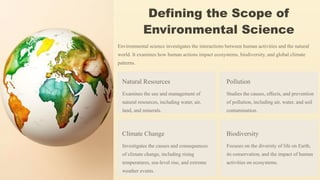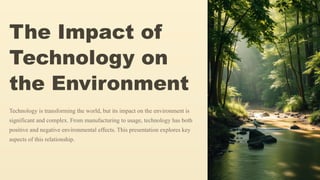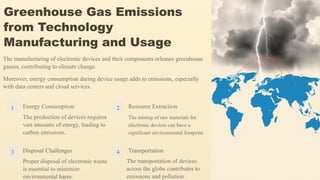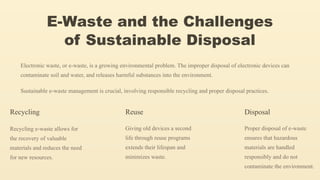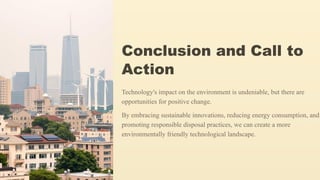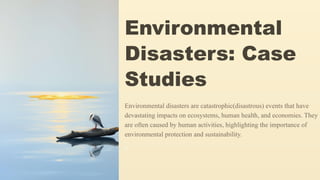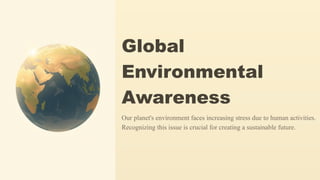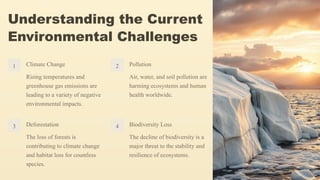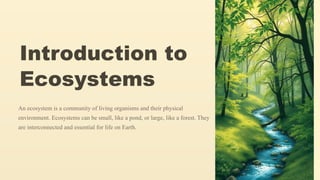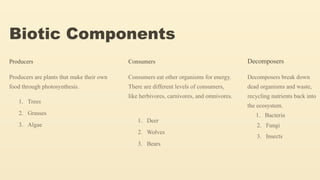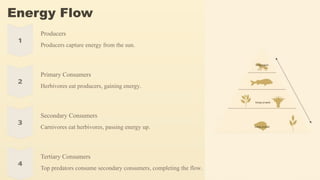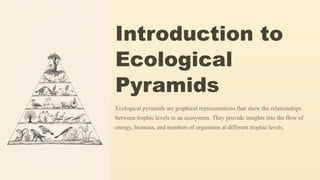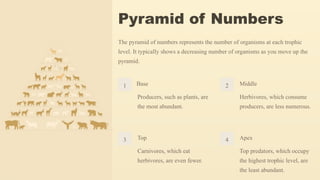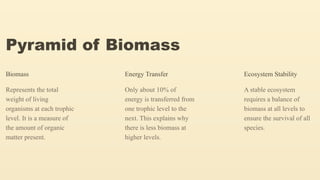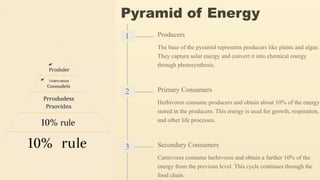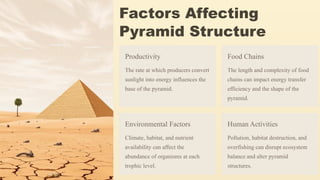Environmentasci ppt.pptxar djsndjnsjndsn
- 1. ENVIRONMENTAL SCIENCE MODULE ŌĆō 1 PRESENTATION ’ü▒ SUBJECT ŌĆō ENVIRONMENTAL SCIENCE ’ü▒ SUBJECT CODE ŌĆō 303104105 ’ü▒ PRESENTED BY ŌĆō 1) KRISH TAILOR UG NO: 24UG036929 2) MANAS PUDI UG NO: 24UG036796 3) NITESH JHA UG NO: 24UG036776 4) ASAAD VAHORA UG NO: 24UG035405
- 2. ’āśObjective and Scope ’āśImpact of Technology on Environment ’āśEnvironmental Disasters : Case Studies ’āśGlobal Environmental Awareness to mitigate stress on Environment ’āśStructure and Function of an Ecosystem ’āśPyramidal Topics TOPICS TO BE COVERED :
- 3. Environmental Science: An Introduction Environmental science is a multidisciplinary field that explores the intricate(complicated) relationships between living organisms and their surroundings. It includes a wide range of subjects, including biology, chemistry, physics, geology, and social sciences.
- 4. Defining the Scope of Environmental Science Environmental science investigates the interactions between human activities and the natural world. It examines how human actions impact ecosystems, biodiversity, and global climate patterns. Natural Resources Examines the use and management of natural resources, including water, air, land, and minerals. Pollution Studies the causes, effects, and prevention of pollution, including air, water, and soil contamination. Climate Change Investigates the causes and consequences of climate change, including rising temperatures, sea-level rise, and extreme weather events. Biodiversity Focuses on the diversity of life on Earth, its conservation, and the impact of human activities on ecosystems.
- 5. Key Components of the Environment The environment consists of interconnected components that interact and influence each other. These components include the atmosphere, hydrosphere, lithosphere, and biosphere. 1 Atmosphere The layer of gases that surrounds the Earth. 2 Hydrosphere All the water on Earth, including oceans, lakes, rivers, and groundwater. 3 Lithosphere The Earth's solid, rocky outer layer. 4 Biosphere The part of Earth where life exists, including all living organisms and their interactions with the environment.
- 6. Importance of Environmental Science in the Modern World Environmental science plays a crucial role in addressing pressing global issues,such as climate change, pollution, and resource depletion. It provides the scientific foundation for informed decision-making and sustainable development. 1 Sustainable Development Environmental science helps identify and implement solutions for sustainable development, balancing economic growth with environmental protection. 2 Resource Management Provides insights into efficient resource management, ensuring the long-term availability of essential resources, such as water and energy. 3 Pollution Control Develops strategies to prevent and mitigate pollution, protecting human health and ecosystems. 4 Climate Change Mitigation Provides scientific knowledge for understanding and addressing climate change, including reducing greenhouse gas emissions and adapting to its impacts.
- 7. The Impact of Technology on the Environment Technology is transforming the world, but its impact on the environment is significant and complex. From manufacturing to usage, technology has both positive and negative environmental effects. This presentation explores key aspects of this relationship.
- 8. Greenhouse Gas Emissions from Technology Manufacturing and Usage The manufacturing of electronic devices and their components releases greenhouse gasses, contributing to climate change. Moreover, energy consumption during device usage adds to emissions, especially with data centers and cloud services. 1 Energy Consumption The production of devices requires vast amounts of energy, leading to carbon emissions. 2 Resource Extraction The mining of raw materials for electronic devices can have a significant environmental footprint. 3 Disposal Challenges Proper disposal of electronic waste is essential to minimize environmental harm. 4 Transportation The transportation of devices across the globe contributes to emissions and pollution.
- 9. E-Waste and the Challenges of Sustainable Disposal Electronic waste, or e-waste, is a growing environmental problem. The improper disposal of electronic devices can contaminate soil and water, and releases harmful substances into the environment. Sustainable e-waste management is crucial, involving responsible recycling and proper disposal practices. Recycling Recycling e-waste allows for the recovery of valuable materials and reduces the need for new resources. Reuse Giving old devices a second life through reuse programs extends their lifespan and minimizes waste. Disposal Proper disposal of e-waste ensures that hazardous materials are handled responsibly and do not contaminate the environment.
- 10. Conclusion and Call to Action Technology's impact on the environment is undeniable, but there are opportunities for positive change. By embracing sustainable innovations, reducing energy consumption, and promoting responsible disposal practices, we can create a more environmentally friendly technological landscape.
- 11. Environmental Disasters: Case Studies Environmental disasters are catastrophic(disastrous) events that have devastating impacts on ecosystems, human health, and economies. They are often caused by human activities, highlighting the importance of environmental protection and sustainability. KT
- 12. Case Study: The Bhopal Gas Tragedy 1984 A gas leak at a Union Carbide pesticide plant in Bhopal, India, released highly toxic methyl isocyanate into the atmosphere. Catastrophe The gas leak caused widespread death and illness, impacting thousands of people and leaving a long-lasting environmental and health legacy. Legacy The Bhopal gas tragedy exposed the dangers of industrial negligence and the need for stricter safety regulations in hazardous industries.
- 13. Case Study: The Deepwater Horizon Oil Spill Marine Life The oil spill had a devastating impact on marine life in the Gulf of Mexico, affecting species like sea turtles, dolphins, and fish. The Explosion The Deepwater Horizon oil spill was caused by an explosion on an oil rig, resulting in a massive leak of crude oil into the ocean.
- 14. Conclusion and Call to Action Protect Our Planet Environmental disasters remind us of our interconnectedness with the environment and the need to protect our planet. Raise Awareness Educating ourselves and others about environmental risks and promoting sustainable practices is crucial to prevent disasters. Take Action We all have a role to play in mitigating environmental risks and creating a more sustainable future.
- 15. Global Environmental Awareness Our planet's environment faces increasing stress due to human activities. Recognizing this issue is crucial for creating a sustainable future.
- 16. Understanding the Current Environmental Challenges 1 Climate Change Rising temperatures and greenhouse gas emissions are leading to a variety of negative environmental impacts. 2 Pollution Air, water, and soil pollution are harming ecosystems and human health worldwide. 3 Deforestation The loss of forests is contributing to climate change and habitat loss for countless species. 4 Biodiversity Loss The decline of biodiversity is a major threat to the stability and resilience of ecosystems.
- 17. Conserving Natural Resources and Reducing Waste Water Conservation Efficient water use in households, agriculture, and industry is crucial for preserving this precious resource. Waste Reduction Minimizing waste generation through responsible consumption and recycling is essential for a sustainable future. Resource Recovery Recovering valuable resources from waste materials helps to conserve natural resources and reduce landfill waste.
- 18. Introduction to Ecosystems An ecosystem is a community of living organisms and their physical environment. Ecosystems can be small, like a pond, or large, like a forest. They are interconnected and essential for life on Earth.
- 19. Abiotic Components 1 Sunlight Sunlight provides the energy that fuels most ecosystems. 2 Temperature Temperature influences the rate of biological processes, and different organisms thrive at different temperatures. 3 Water Water is essential for all life and its availability affects plant and animal life. 4 Soil Soil provides nutrients and support for plants and is home to many organisms.
- 20. Biotic Components Producers Producers are plants that make their own food through photosynthesis. 1. Trees 2. Grasses 3. Algae Consumers Consumers eat other organisms for energy. There are different levels of consumers, like herbivores, carnivores, and omnivores. 1. Deer 2. Wolves 3. Bears Decomposers Decomposers break down dead organisms and waste, recycling nutrients back into the ecosystem. 1. Bacteria 2. Fungi 3. Insects
- 21. Energy Flow Producers Producers capture energy from the sun. Primary Consumers Herbivores eat producers, gaining energy. Secondary Consumers Carnivores eat herbivores, passing energy up. Tertiary Consumers Top predators consume secondary consumers, completing the flow.
- 22. Ecosystem Services The benefits that humans derive from ecosystems. Clean Air Plants absorb carbon dioxide and release oxygen. Clean Water Ecosystems filter and purify water sources. Pollination Insects and other animals help plants reproduce. Climate Regulation Ecosystems help regulate temperature and weather patterns.
- 23. Introduction to Ecological Pyramids Ecological pyramids are graphical representations that show the relationships between trophic levels in an ecosystem. They provide insights into the flow of energy, biomass, and numbers of organisms at different trophic levels.
- 24. Pyramid of Numbers The pyramid of numbers represents the number of organisms at each trophic level. It typically shows a decreasing number of organisms as you move up the pyramid. 1 Base Producers, such as plants, are the most abundant. 2 Middle Herbivores, which consume producers, are less numerous. 3 Top Carnivores, which eat herbivores, are even fewer. 4 Apex Top predators, which occupy the highest trophic level, are the least abundant.
- 25. Pyramid of Biomass Biomass Represents the total weight of living organisms at each trophic level. It is a measure of the amount of organic matter present. Energy Transfer Only about 10% of energy is transferred from one trophic level to the next. This explains why there is less biomass at higher levels. Ecosystem Stability A stable ecosystem requires a balance of biomass at all levels to ensure the survival of all species.
- 26. Pyramid of Energy 1 Producers The base of the pyramid represents producers like plants and algae. They capture solar energy and convert it into chemical energy through photosynthesis. 2 Primary Consumers Herbivores consume producers and obtain about 10% of the energy stored in the producers. This energy is used for growth, respiration, and other life processes. 3 Secondary Consumers Carnivores consume herbivores and obtain a further 10% of the energy from the previous level. This cycle continues through the food chain.
- 27. Factors Affecting Pyramid Structure Productivity The rate at which producers convert sunlight into energy influences the base of the pyramid. Food Chains The length and complexity of food chains can impact energy transfer efficiency and the shape of the pyramid. Environmental Factors Climate, habitat, and nutrient availability can affect the abundance of organisms at each trophic level. Human Activities Pollution, habitat destruction, and overfishing can disrupt ecosystem balance and alter pyramid structures.
- 28. Conclusion and Key Takeaways Ecological pyramids are fundamental tools for understanding the structure and dynamics of ecosystems. Trophic Levels They illustrate the relationships between organisms at different trophic levels. Energy Flow They depict the flow of energy through the ecosystem, emphasizing the importance of producers. Conservation They highlight the importance of maintaining the balance of ecosystems for the well-being of all life.



